Stochastic Adaptive Robust Dispatch for Virtual Power Plants Using the Binding Scenario Identification Approach
Abstract
:1. Introduction
- This paper establishes a stochastic adaptive robust model for VPP dispatch that considers CACS and multiple markets. The stochastic programming approach is used to address the uncertainty of market electricity price owing to the high accuracy of market price forecasting, and the adaptive robust method is used to address the uncertainty of PV output owing to the low accuracy of PV output forecasting.
- The binding scenario identification approach is used to solve the stochastic adaptive robust model for VPP dispatch. The original problem is decomposed into a master problem for solving the single-level optimization model with the binding scenario subset and a sub-problem for identifying the binding scenario subset, which greatly reduces the number of scenarios and the number of iterations required for the solution process. In addition, auxiliary variables are also introduced rather than applying a cyclic solution process for the sub-problem to reduce the number of times that the sub-problem must be solved.
- This paper quantitatively evaluates the key factors affecting VPP profit, and the VPP scheduling of aggregated units is analyzed. The results of a case study indicate that the binding scenario identification algorithm effectively improves the computational efficiency of the solution process, and is scalable to large-scale scenarios.
2. Central Air-Conditioning Systems
2.1. Comfort Index of the Human Body
2.2. Central Air-Conditioning System Model
3. VPP Model Formulation
3.1. Deterministic VPP Model
3.1.1. Objective Function
3.1.2. Constraints of Aggregated Units
3.2. Stochastic Adaptive Robust Model for VPP Dispatch
- In the DAM decision-making stage (i.e., the pre-decision stage), the VPP determines the on/off statuses of the gas turbine and the DAM trading volume with the objective of maximizing profit.
- In the RTM decision-making stage (i.e., the re-decision stage), the VPP first considers the PV output of all scenarios on the basis of the realization of decision variables obtained at the DAM stage, and selects the worst-case scenario that minimizes the profit. Second, the VPP determines the RTM trading volume and other variables after the realization of the day-ahead decision variables and PV output with the objective of maximizing the profit.
4. Binding Scenario Identification
4.1. Master Problem
4.2. Sub-Problem
- For nonlinear (nonconvex) problems, the optimality condition is false, which is not an appropriate condition for the CCG algorithm, while it is acceptable for the binding scenario identification algorithm.
- The scenario set used in the binding scenario identification algorithm to describe PV output uncertainty is more accurate than the box or polyhedron uncertainty set used in the CCG algorithm [47].
- The number of iterations required by the CCG algorithm depends on the coupling between each level of the problem, and may be quite large, while the number of iterations required by the binding scenario identification algorithm is limited because the number of binding scenarios is related to the uncertain scenario set and has nothing to do with the problem itself.
4.3. Solution Procedure
- Define an initial binding scenario subset , where is the initial PV output scenario.
- Solve the master problem with , and denote the first stage decision variables {, , , , } obtained from the master problem as .
- Substitute into the sub-problem and calculate with the PV output scenario set . Solve to identify .
- Compare obtained in the master problem with obtained in the sub-problem. If , includes the uncertainty information of all scenarios. Go to Step 5. Otherwise, add the scenario obtained to , and go to Step 2.
- Output the optimal scheduling results obtained in Step 2.
5. Case Study
5.1. VPP Description and Parameter Settings
5.2. Simulation Results
5.2.1. Analysis of the Factors Influencing VPP Profit
5.2.2. Analysis of Optimized VPP Dispatch Results
5.2.3. Analysis of Iteration Performance
5.2.4. Analysis of Adaptability to Large-scale Scenario Sets
5.2.5. Comparative Analysis of the Binding Scenario Identification Approach
6. Conclusions
- Simultaneous participation in the DAM, RTM, and CTM allows the VPP to dispatch flexibly according to the electricity market price, which improves the profitability of the VPP and adapts its functionality to emerging low carbon emission requirements.
- The VPP can conduct the coordinated scheduling of aggregated units, such as the interruptible load and CACS, to reduce electricity consumption during high electricity price periods and alleviate problems associated with peak loads via load shifting.
- The binding scenario identification approach greatly reduces the number of scenarios that must be considered, and thereby increases the computational efficiency of the solution algorithm. The required computation time increases slowly with increasing size of the scenario set, so that the solution algorithm is adaptable to the stochastic adaptive robust VPP dispatch model with large-scale scenario sets.
- The binding scenario identification approach accurately identifies the binding scenario subset, and therefore attains an equivalent solution accuracy as that of the standard scenario-based approach, while providing a greatly increased computational efficiency.
Author Contributions
Funding
Conflicts of Interest
Appendix A
| Maximum/Minimum Output (MW) | Ramp-up/Ramp-down Limit (MW/h) | Start-up/Shut-down Cost (€) | Fixed Production Cost (€) |
| 5.67/2.5 | 3/3 | 30/30 | 30 |
| Slope of Segment l/2/3 (€/MW) | Minimum Up/Down Time (h) | Initial Up/Down Time (h) | Carbon Emission Coefficient/Quota (t/MWh) |
| 40/45/50 | 2/2 | 0/1 | 0.184/0.3863 |
| ηst | ηre | μch | μst | μre | ||||
|---|---|---|---|---|---|---|---|---|
| 10 | 5 | 5 | 26.4 | 0.95 | 0.92 | 5.6 | 0.008 | 0.007 |
| ηc | ηd | |||
|---|---|---|---|---|
| 8 | 8 | 40 | 0.9 | 0.9 |
| Type | Kwall,q * (W/(m2·K)) | Kwall,d * (W/(m2·K)) | Awall/Awin | (Tcl+Td)E ** (°C) | (Tcl+Td)S ** (°C) |
| Building | 1.49 | 0.6 | 0.7/0.3 | 39 | 35.6 |
| (Tcl+Td)W ** (°C) | (Tcl+Td)N ** (°C) | (Tcl+Td)H ** (°C) | Kwin(W/(m2·K)) | qwin,E ** (W/m2) | qwin,W ** (W/m2) |
| 39.4 | 34.9 | 37.6 | 5.8 | 531 | 531 |
| qwin,S ** (W/m2) | qwin,N ** (W/m2) | Fcl,E ** | Fcl,S ** | Fcl,W ** | Fcl,N ** |
| 195 | 145 | 0.31 | 0.81 | 0.24 | 0.85 |
| Fd | Fs | k1 | k2 | k3 | k4 |
| 0.93 | 1 | 0.7 | 0.7 | 1 | 0.85 |
| k5 | k6 | k7 | Sh(W/(m2·K)) | Ccl | qsh(W) |
| 1 | 1 | 0.7 | 10.63 | 0.03 | 63.94 |
| qlh(W) | φ | Gn(m3/per·h) | n | Ple,ep *** (kW) | Ple,lp *** (kW) |
| 117.46 | 0.89 | 10 | 3000 | 1280.13 | 1280.13 |
| Phe,ep *** (kW) | Phe,lp *** (kW) | Ain,ep *** (m2) | Ain,lp *** (m2) | Ca(J/kg·°C) | ρa(kg /m3) |
| — | — | 4704.7 | 4704.7 | 0.28 | 1.29 |
| Optimized Results | Case 6 | Case 7 | Case 8 | Case 9 | Case 10 |
|---|---|---|---|---|---|
| Number of scenarios | 400 | 500 | 600 | 700 | 800 |
| Computation time of binding scenario approach(s) | 66.56 | 86.63 | 110.34 | 133.67 | 165.48 |
| Computation timeof standard scenario-based approach(s) | 421.44 | 882.88 | 1049 | Unsolvable | Unsolvable |
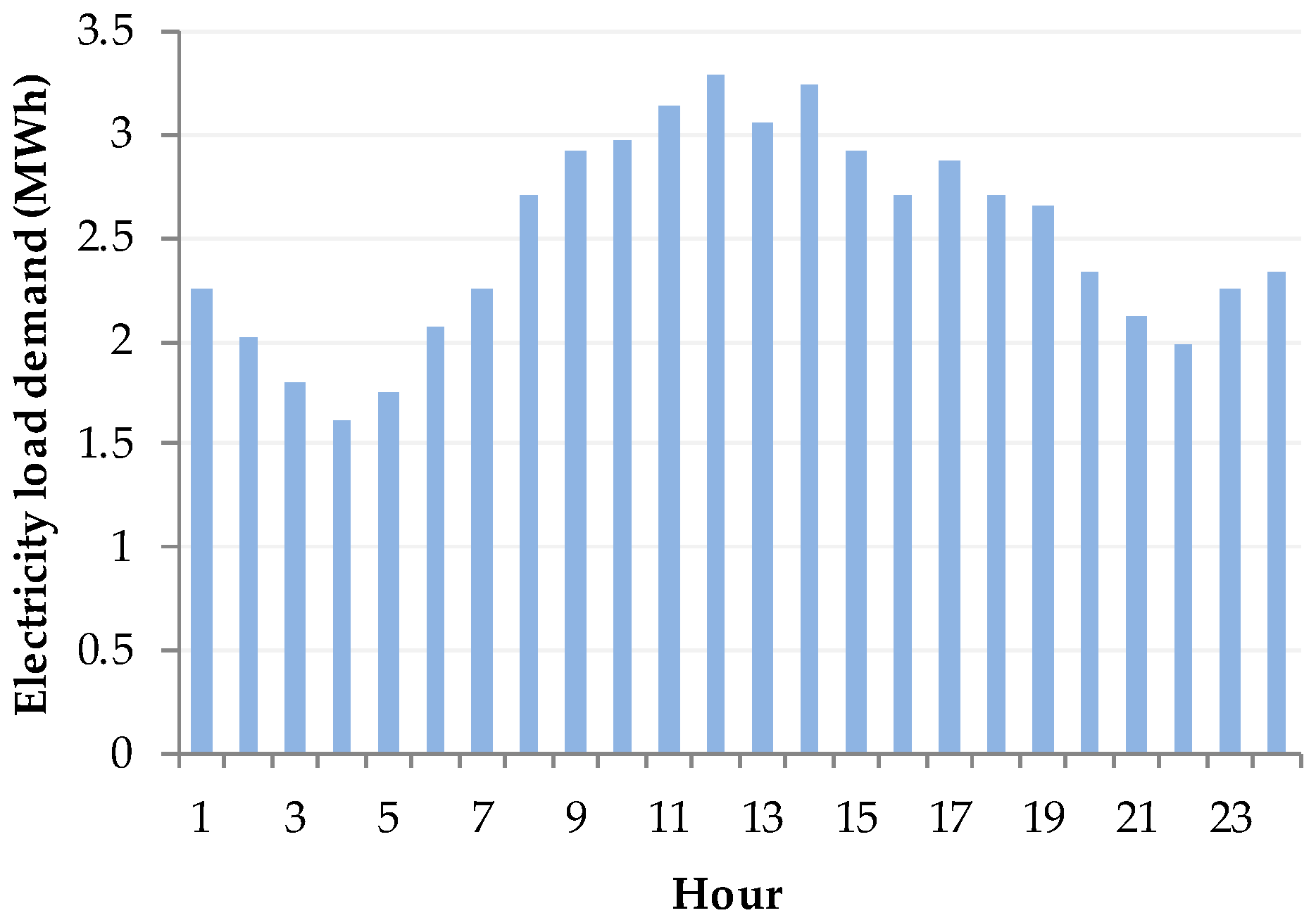
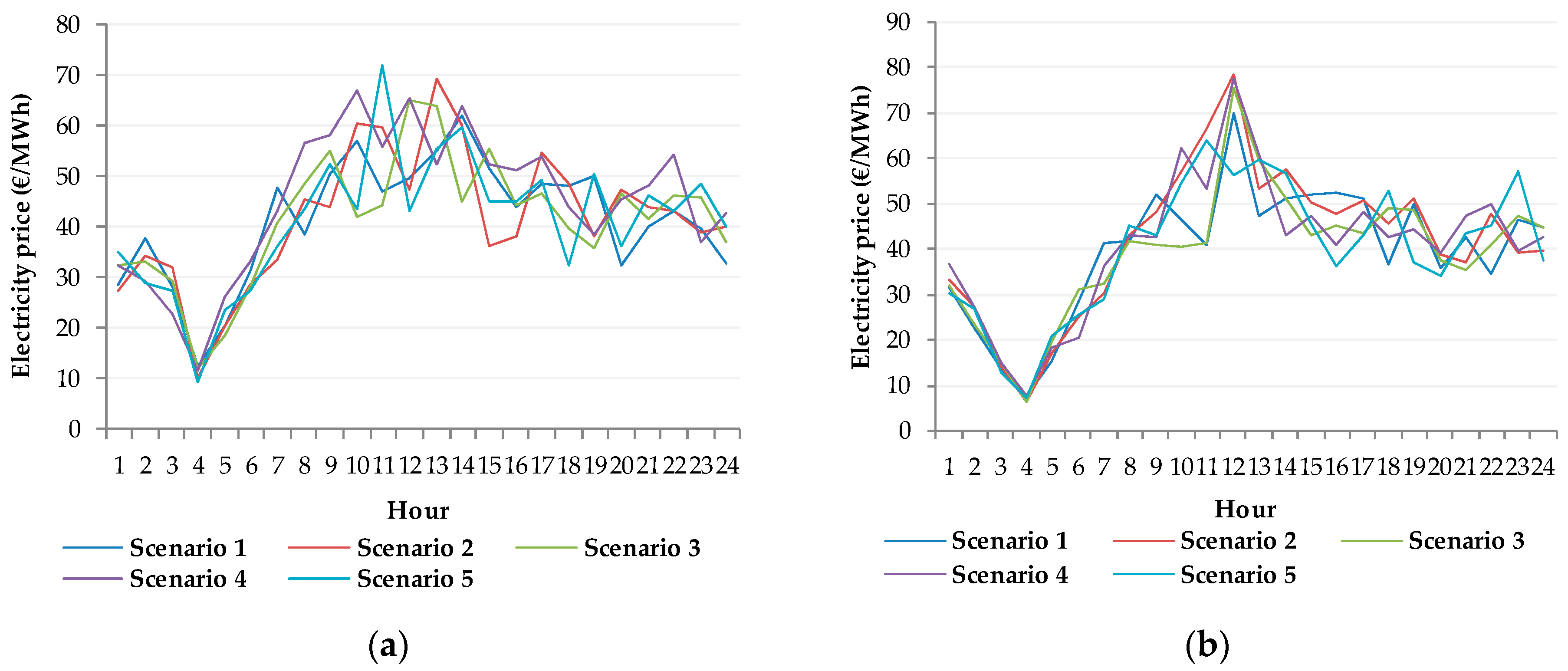
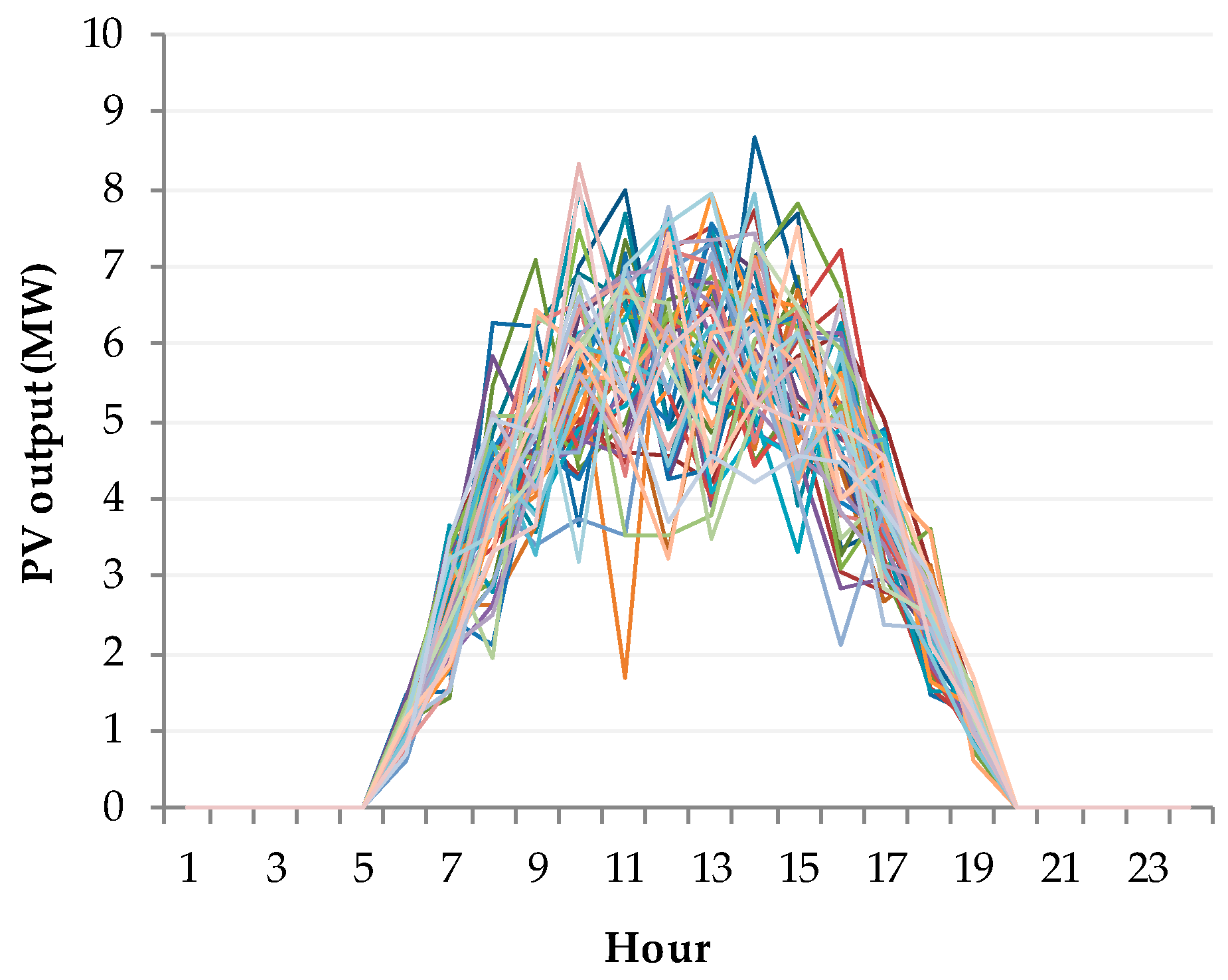
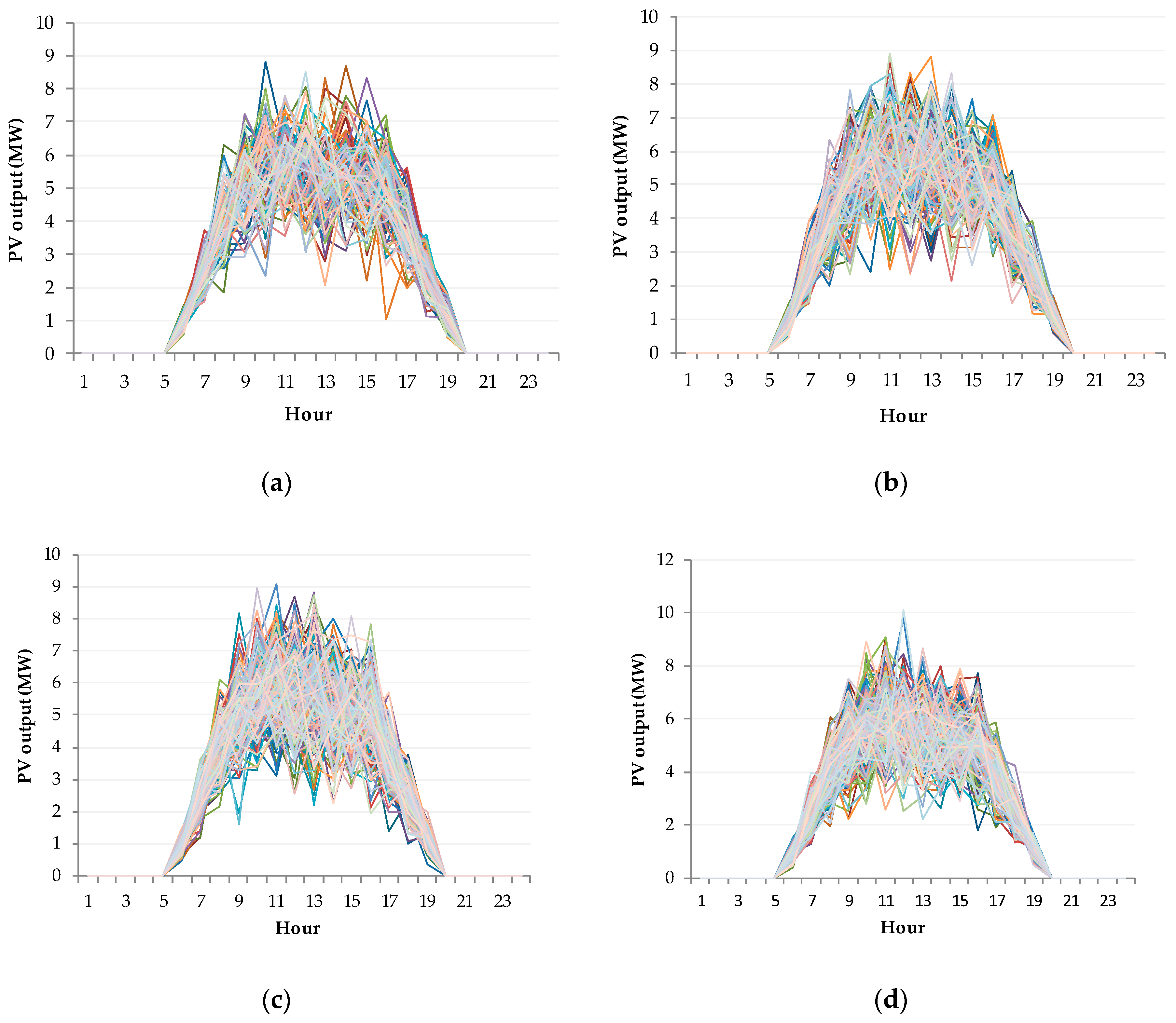
References
- Pourakbari-Kasmaei, M.; Mantovani, J.R.S.; Rashidinejad, M.; Habibi, M.R.; Contreras, J. Carbon footprint allocation among consumers and transmission losses. In Proceedings of the 2017 IEEE International Conference Environment and Electrical Engineering and 2017 IEEE Industrial and Commercial Power Systems Europe (EEEIC/I&CPS Europe), Milan, Italy, 6–9 June 2017. [Google Scholar]
- Tofis, Y.; Yiasemi, Y.; Kyriakides, E. A plug-and-play selective load shedding scheme for power systems. IEEE Syst. J. 2017, 11, 2864–2871. [Google Scholar] [CrossRef]
- Li, H.; Eseye, A.T.; Zhang, J.; Zheng, D. Optimal energy management for industrial microgrids with high-penetration renewables. Prot. Control Mod. Power Syst. 2017, 2, 12. [Google Scholar] [CrossRef]
- Wang, J.; Yang, W.; Cheng, H.; Huang, L.; Gao, Y. The Optimal Configuration Scheme of the Virtual Power Plant Considering Benefits and Risks. Energies 2017, 10, 968. [Google Scholar] [CrossRef]
- Li, J.; Wang, S.; Ye, L.; Fang, J. A coordinated dispatch method with pumped-storge and battery-storage for compensating the variation of wind power. Prot. Control Mod. Power Syst. 2018, 3, 2. [Google Scholar] [CrossRef]
- Zang, H.; Cheng, L.; Ding, T.; Cheung, K.W.; Liang, Z.; Wei, Z.; Sun, G. Hybrid method for short-term photovoltaic power forecasting based on deep convolutional neural network. IET Gener. Transm. Distrib. 2018, 12, 4557–4567. [Google Scholar] [CrossRef]
- Magdy, G.; Mohamed, E.A.; Shabib, G.; Elbaset, A.A.; Mitani, Y. Microgrid dynamic security considering high penetration of renewable energy. Prot. Control Mod. Power Syst. 2018, 3, 23. [Google Scholar] [CrossRef]
- Bashir, A.A.; Pourakbari-Kasmaei, M.; Contreras, J.; Lehtonen, M. A novel energy scheduling framework for reliable and economic operation of islanded and grid-connected microgrids. Electr. Power Syst. Res. 2019, 171, 85–96. [Google Scholar] [CrossRef]
- Luo, J.; Cao, Y.; Yang, W.; Yang, Y.; Zhao, Z.; Tian, S. Optimal Operation Modes of Virtual Power Plants Based on Typical Scenarios Considering Output Evaluation Criteria. Energies 2018, 11, 2634. [Google Scholar] [CrossRef]
- Home-Ortiz, J.M.; Pourakbari-Kasmaei, M.; Lehtonen, M.; Mantovani, J.R.S. Optimal location-allocation of storage devices and renewable-based DG in distribution systems. Electr. Power Syst. Res. 2019, 172, 11–21. [Google Scholar] [CrossRef]
- Qiu, J.; Zhao, J.; Wang, D.; Zheng, Y. Two-stage coordinated operational strategy for distributed energy resources considering wind power curtailment penalty cost. Energies 2017, 10, 965. [Google Scholar] [CrossRef]
- Rahimiyan, M.; Baringo, L. Strategic bidding for a virtual power plant in the day-ahead and real-time markets: Price-taker robust optimization approach. IEEE Trans. Power Syst. 2016, 31, 2676–2687. [Google Scholar] [CrossRef]
- Wang, Y.; Ai, X.; Tan, Z.; Yan, L.; Liu, S. Interactive dispatch modes and bidding strategy of multiple virtual power plants based on demand response and game theory. IEEE Trans. Smart Grid 2015, 7, 510–519. [Google Scholar] [CrossRef]
- Pazouki, S.; Haghifam, M.R.; Pazouki, S. Transition from fossil fuels power plants toward Virtual Power Plants of distribution networks. In Proceedings of the 2016 21st Conference on Electrical Power Distribution Networks Conference (EPDC), Karaj, Iran, 26–27 April 2016. [Google Scholar]
- Liang, Z.; Alsafasfeh, Q.; Jin, T.; Pourbabak, H.; Su, W. Risk-constrained optimal energy management for virtual power plants considering correlated demand response. IEEE Trans. Smart Grid 2017, 10, 1577–1587. [Google Scholar] [CrossRef]
- Al-Awami, A.T.; Amleh, N.; Muqbel, A. Optimal demand response bidding and pricing mechanism with fuzzy optimization: Application for a virtual power plant. IEEE Trans. Ind. Appl. 2017, 53, 5051–5061. [Google Scholar] [CrossRef]
- Kardakos, E.G.; Simoglou, C.K.; Bakirtzis, A.G. Optimal offering strategy of a virtual power plant: A stochastic bi-level approach. IEEE Tran. Smart Grid 2015, 7, 794–806. [Google Scholar] [CrossRef]
- Gao, Y.; Xue, F.; Yang, W.; Yang, Q.; Sun, Y.; Sun, Y.; Liang, H.; Li, P. Optimal operation models of photovoltaic-battery energy storage system based power plants considering typical scenarios. Prot. Control Mod. Power Syst. 2017, 2, 397–406. [Google Scholar] [CrossRef]
- Pandžić, H.; Kuzle, I.; Capuder, T. Virtual power plant mid-term dispatch optimization. Appl. Energy 2013, 101, 134–141. [Google Scholar] [CrossRef]
- Ding, H.; Hu, Z.; Song, Y. Stochastic optimization of the daily operation of wind farm and pumped-hydro-storage plant. Renew. Energy 2012, 48, 571–578. [Google Scholar] [CrossRef]
- Dabbagh, S.R.; Sheikh-El-Eslami, M.K. Risk assessment of virtual power plants offering in energy and reserve markets. IEEE Trans. Power Syst. 2015, 31, 3572–3582. [Google Scholar] [CrossRef]
- Zhou, Y.; Wei, Z.; Sun, G.; Cheung, K.W.; Zang, H.; Chen, S. A robust optimization approach for integrated community energy system in energy and ancillary service markets. Energy 2018, 148, 1–15. [Google Scholar] [CrossRef]
- Ju, L.; Li, H.; Zhao, J.; Chen, K.; Tan, Q.; Tan, Z. Multi-objective stochastic scheduling optimization model for connecting a virtual power plant to wind-photovoltaic-electric vehicles considering uncertainties and demand response. Energy Conv. Manag. 2016, 128, 160–177. [Google Scholar] [CrossRef]
- Shayegan-Rad, A.; Badri, A.; Zangeneh, A. Day-ahead scheduling of virtual power plant in joint energy and regulation reserve markets under uncertainties. Energy 2017, 121, 114–125. [Google Scholar] [CrossRef]
- Zhao, C.; Guan, Y. Unified stochastic and robust unit commitment. IEEE Trans. Power Syst. 2013, 28, 3353–3361. [Google Scholar] [CrossRef]
- An, Y.; Zeng, B. Exploring the modeling capacity of two-stage robust optimization: Variants of robust unit commitment model. IEEE Trans. Power Syst. 2015, 30, 109–122. [Google Scholar] [CrossRef]
- Jiang, R.; Wang, J.; Guan, Y. Robust unit commitment with wind power and pumped storage hydro. IEEE Trans. Power Syst. 2012, 27, 800–810. [Google Scholar] [CrossRef]
- Ding, T.; Liu, S.; Yuan, W.; Bie, Z.; Zeng, B. A two-stage robust reactive power optimization considering uncertain wind power integration in active distribution networks. IEEE Trans. Sustain. Energy 2016, 7, 301–311. [Google Scholar] [CrossRef]
- Bertsimas, D.; Brown, D.B.; Caramanis, C. Theory and applications of robust optimization. Siam Rev. 2011, 53, 464–501. [Google Scholar] [CrossRef]
- Baringo, A.; Baringo, L. A stochastic adaptive robust optimization approach for the offering strategy of a virtual power plant. IEEE Trans. Power Syst. 2017, 32, 3492–3504. [Google Scholar] [CrossRef]
- Charwand, M.; Ahmadi, A.; Heidari, A.R.; Nezhad, A.E. Benders decomposition and normal boundary intersection method for multiobjective decision making framework for an electricity retailer in energy markets. IEEE Syst. J. 2015, 9, 1475–1484. [Google Scholar] [CrossRef]
- Morales, J.M.; Conejo, A.J.; Madsen, H.; Pinson, P.; Zugno, M. Integrating Renewables in Electricity Markets: Operational Problems, 1st ed.; Springer: Berlin, Germany, 2014; pp. 57–91. [Google Scholar]
- Chen, S.; Wei, Z.; Sun, G.; Cheung, K.W.; Wang, D.; Zang, H. Adaptive Robust Day-Ahead Dispatch for Urban Energy Systems. IEEE Trans. Ind. Electron. 2019, 66, 1379–1390. [Google Scholar] [CrossRef]
- Soares, T.; Bessa, R.J.; Pinson, P.; Morais, H. Active distribution grid management based on robust ac optimal power flow. IEEE Trans. Smart Grid 2017, 9, 6229–6241. [Google Scholar] [CrossRef]
- Nian, F.; Wang, K. Study on indoor environmental comfort based on improved PMV index. In Proceedings of the 2017 3rd International Conference on Computational Intelligence & Communication Technology (CICT), Ghaziabad, India, 13 July 2017. [Google Scholar]
- Chaudhuri, T.; Chai, S.Y.; Bose, S.; Xie, L.; Hua, L. On assuming Mean Radiant Temperature equal to Air Temperature during PMV-based Thermal Comfort Study in Air-conditioned Buildings. In Proceedings of the IECON 2016 - 42nd Annual Conference of the IEEE Industrial Electronics Society, Florence, Italy, 23–26 October 2016. [Google Scholar]
- International Organization for Standardization. ISO 7730. Moderate Thermal Environment-Determination of PMV and PPD Indices and Specification of the Condition for Thermal Comfort; International Organization for Standardization: Geneva, Switzerland, 2005. [Google Scholar]
- Zhang, H.; Wen, F.; Zhang, C.; Meng, J.; Lin, G.; Dang, S. Operation optimization model of home energy hubs considering comfort level of customers. Autom. Electr. Power Syst. 2016, 40, 32–39. [Google Scholar]
- Liu, Z.; Zheng, W.; Qi, F.; Wang, L.; Zou, B.; Wen, F.; Xue, Y. Optimal Dispatch of a Virtual Power Plant Considering Demand Response and Carbon Trading. Energies 2018, 11, 1488. [Google Scholar] [CrossRef]
- Song, M.; Gao, C.; Su, W. Modeling and controlling of air-conditioning load for demand response applications. Autom. Electr. Power Syst. 2016, 40, 158–167. [Google Scholar]
- Song, M.; Gao, C.; Yang, J.; Liu, Y.; Cui, G. Novel aggregate control model of air conditioning loads for fast regulation service. IET Gener. Transm. Distrib. 2017, 11, 4391–4401. [Google Scholar] [CrossRef]
- Xu, Q.; Yang, C.; Yan, Q. Strategy of day-ahead power peak load shedding considering thermal equilibrium inertia of large-scale air conditioning loads. Power Syst. Technol. 2016, 40, 156–163. [Google Scholar]
- Pandžić, H.; Morales, J.M.; Conejo, A.J.; Kuzle, I. Offering model for a virtual power plant based on stochastic programming. Appl. Energy 2013, 105, 282–292. [Google Scholar] [CrossRef]
- Shabanzadeh, M.; Sheikh-El-Eslami, M.K.; Haghifam, M.R. An interactive cooperation model for neighboring virtual power plants. Appl. Energy 2017, 200, 273–289. [Google Scholar] [CrossRef]
- Zhang, W.; Sun, P. Optimal scheduling of power system with photovoltaic power supply considering regional carbon trading. J. Eng. 2017, 13, 1880–1884. [Google Scholar] [CrossRef]
- Shanghai Development and Reform Commission. Circular on the Issuance of Shanghai’s Carbon Emission Quota Allocation Scheme 2017. Available online: http://www.cecol.com.cn/news/20171227/12460327.html (accessed on 27 December 2017).
- Melgar-Dominguez, O.D.; Pourakbari-Kasmaei, M.; Mantovani, J.R.S. Adaptive robust short-term planning of electrical distribution systems considering siting and sizing of renewable energy-based dg units. IEEE Trans. Sustain. Energy 2019, 10, 158–169. [Google Scholar] [CrossRef]
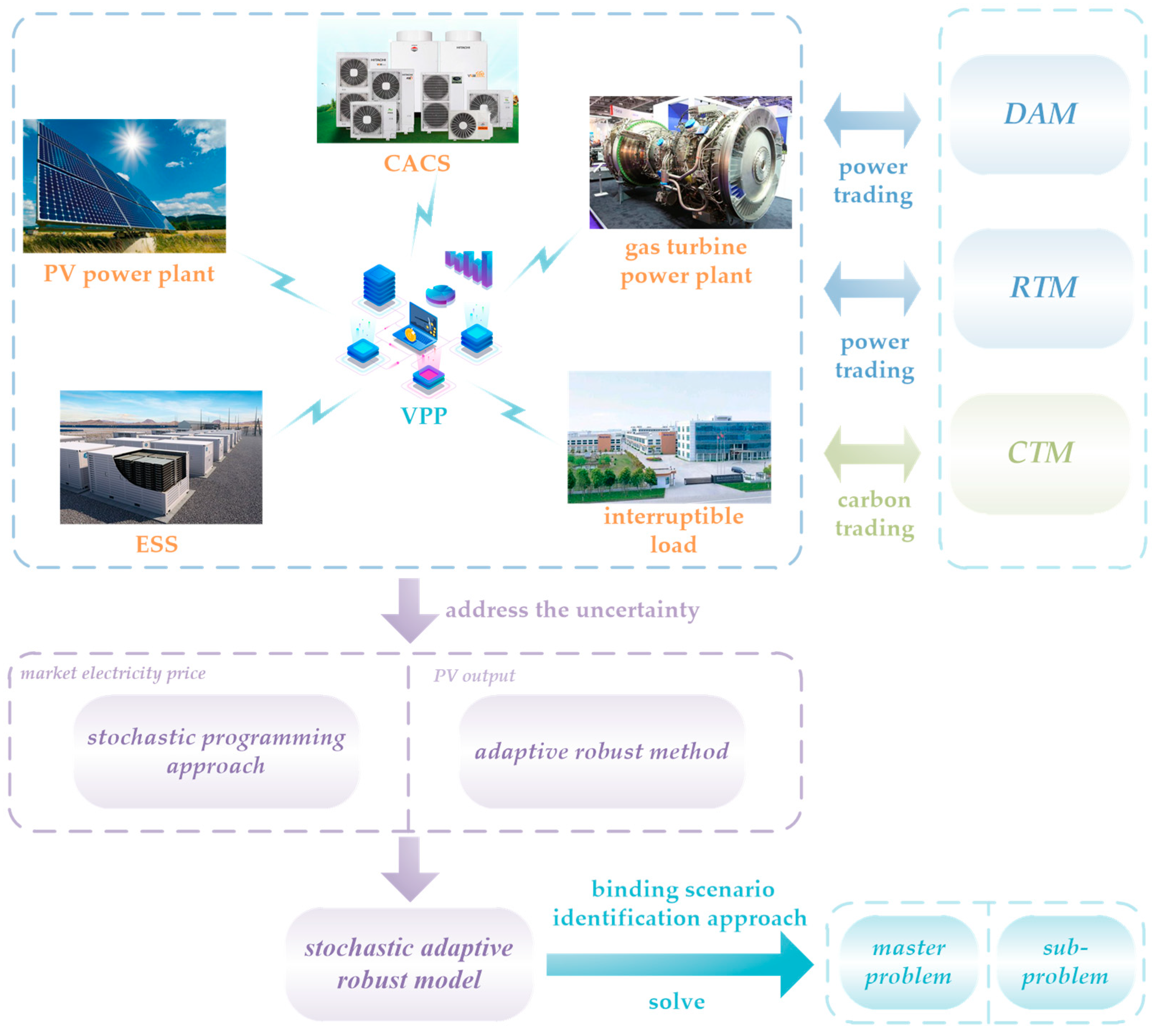
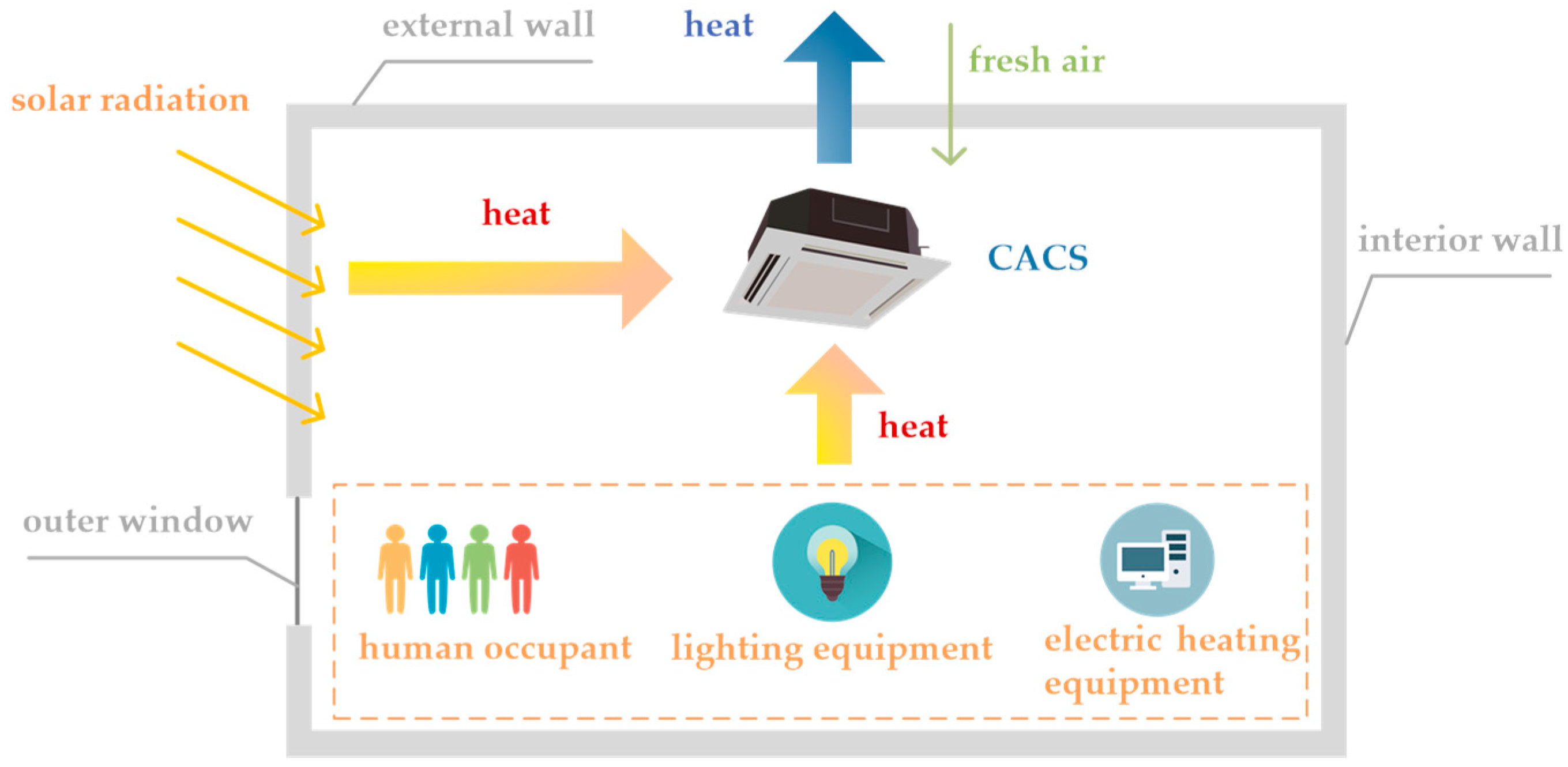


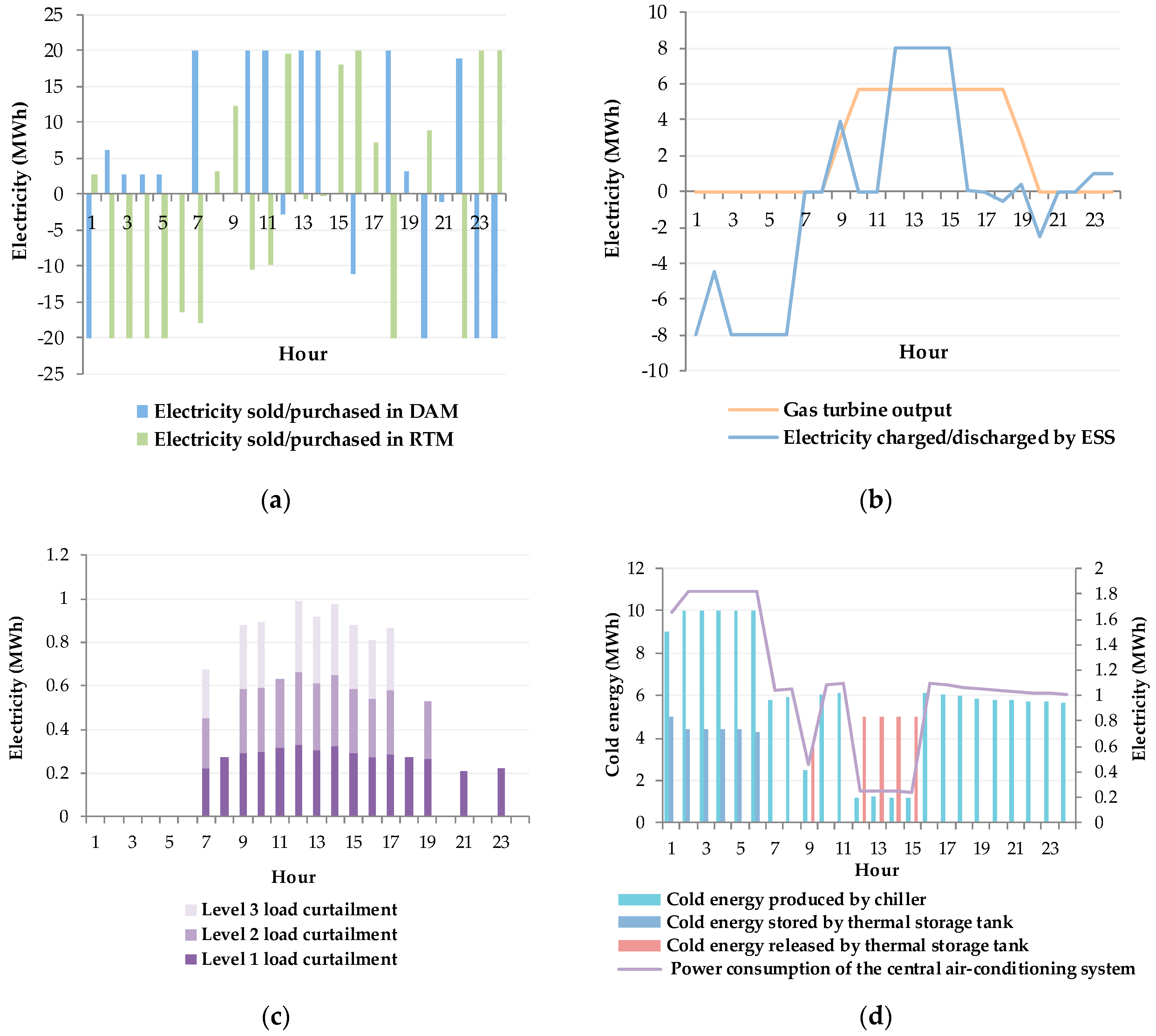
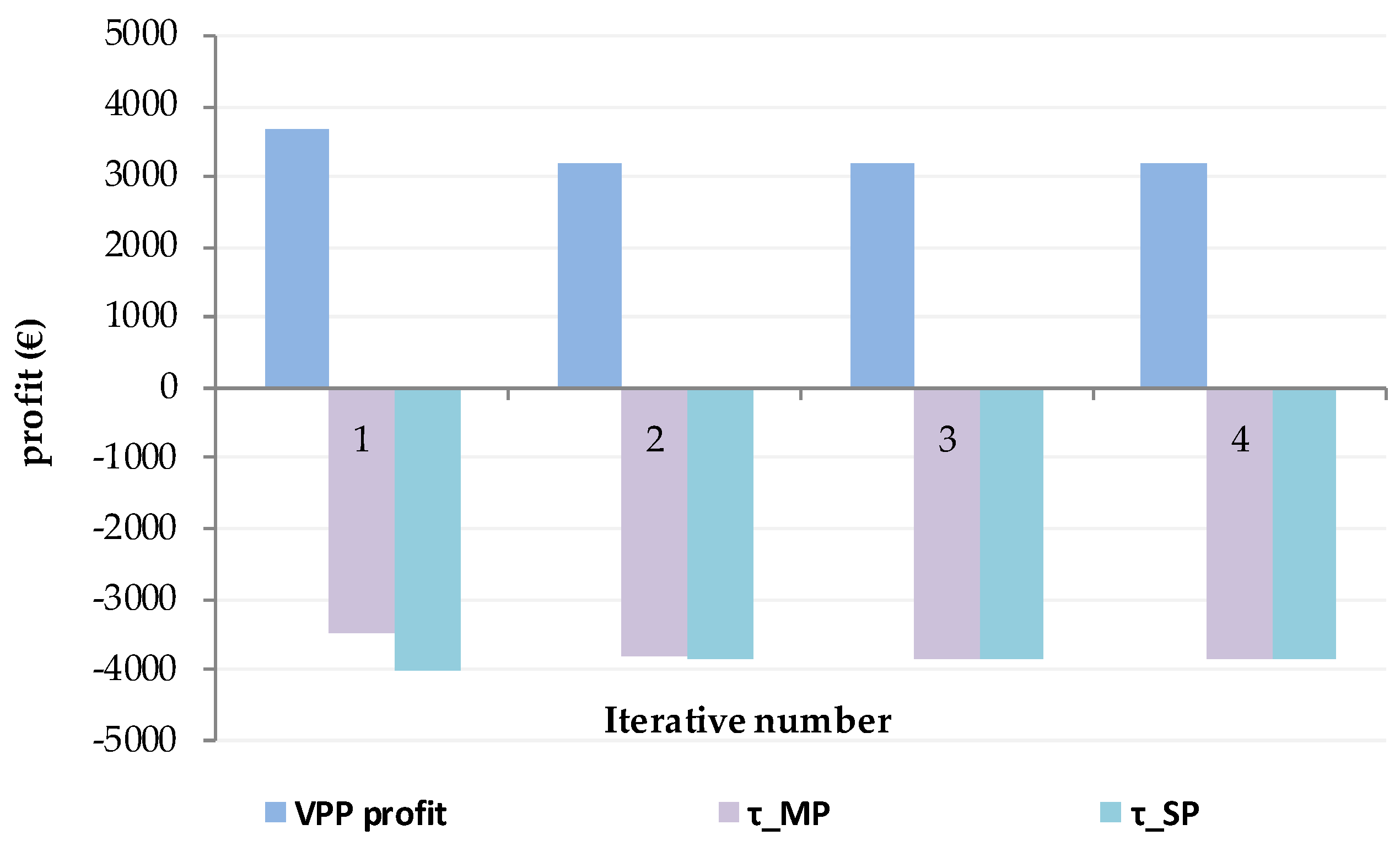
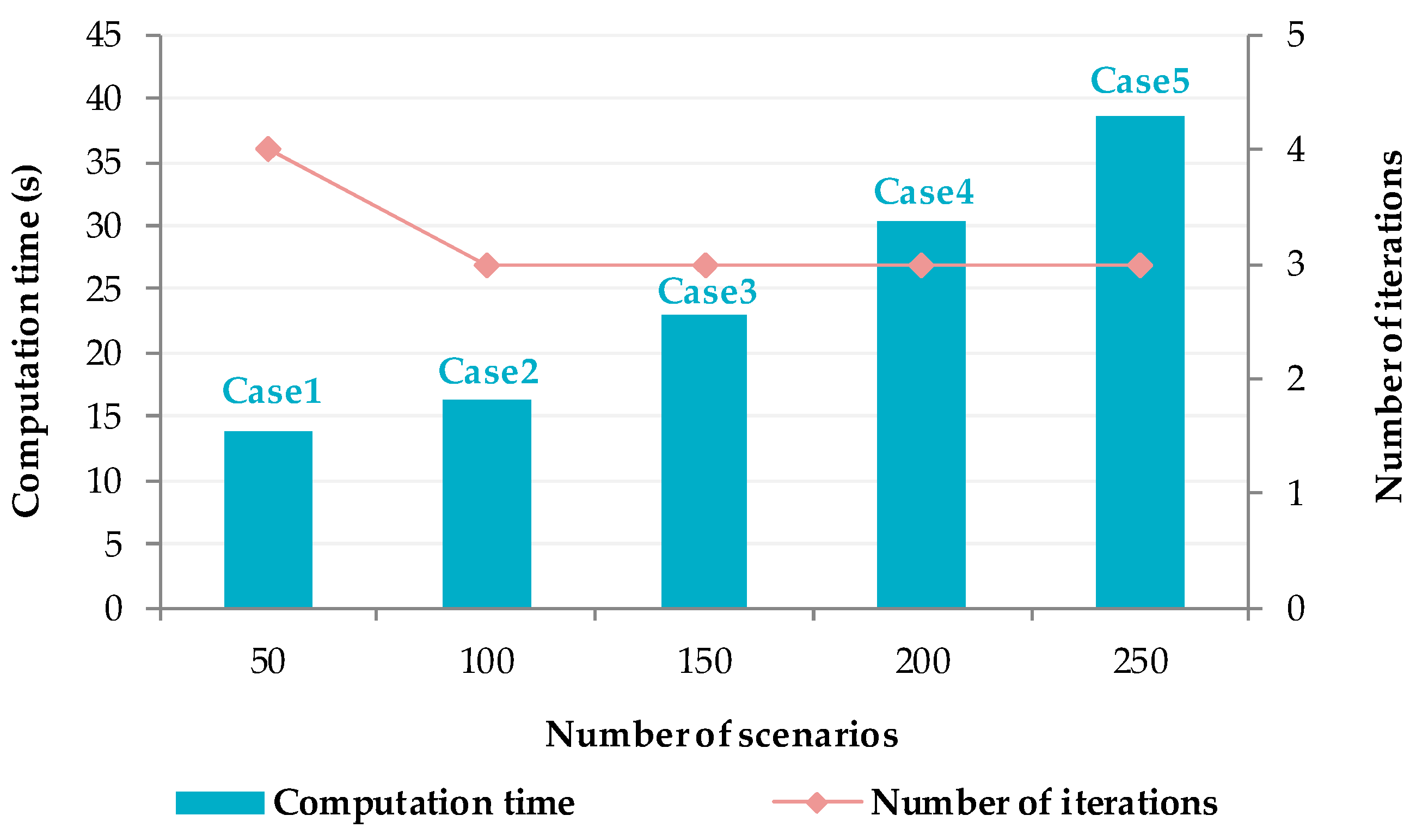
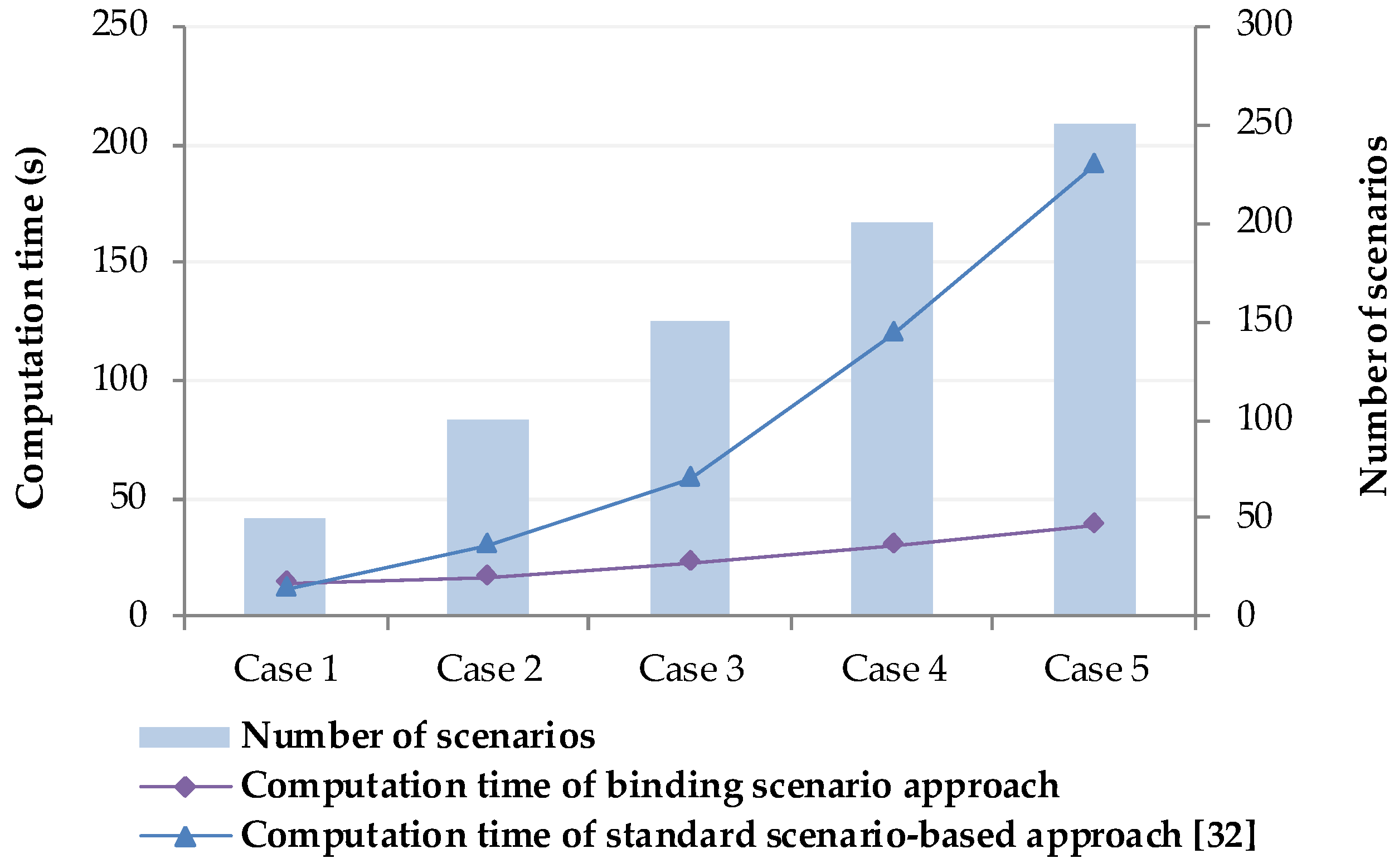
| Scheme | Participate in DAM | Participate in RTM | Participate in CTM | Regulate Central Air-Conditioner | VPP Profit (€) |
|---|---|---|---|---|---|
| 1 | √ | × | × | √ | 1104.63 |
| 2 | √ | × | √ | √ | 1358.43 |
| 3 | √ | √ | × | √ | 2925.01 |
| 4 | √ | √ | √ | × | 3060.59 |
| 5 | √ | √ | √ | √ | 3199.39 |
| Optimized Results | Case 1 | Case 2 | Case 3 | Case 4 | Case 5 |
|---|---|---|---|---|---|
| Number of scenarios | 50 | 100 | 150 | 200 | 250 |
| Number of iterations | 4 | 3 | 3 | 3 | 3 |
| Binding scenariosubsets | 1/23/49/37 | 1/12/9 | 1/110/32 | 1/41/186 | 1/171/14 |
| VPP profit of binding scenario approach (€) | 3199.4 | 2932.4 | 2862.3 | 2836.6 | 2929.7 |
| VPP profit of standard scenario-based approach (€) | 3199.4 | 2932.4 | 2862.3 | 2836.6 | 2929.7 |
| Auxiliary variableof binding scenario approach (€) | −3848.1 | −3848.1 | −4021.1 | −3954.9 | −3951.6 |
| Auxiliary variableof standard scenario-based approach (€) | −3848.1 | −3848.1 | −4021.1 | −3954.9 | −3951.6 |
© 2019 by the authors. Licensee MDPI, Basel, Switzerland. This article is an open access article distributed under the terms and conditions of the Creative Commons Attribution (CC BY) license (http://creativecommons.org/licenses/by/4.0/).
Share and Cite
Sun, G.; Qian, W.; Huang, W.; Xu, Z.; Fu, Z.; Wei, Z.; Chen, S. Stochastic Adaptive Robust Dispatch for Virtual Power Plants Using the Binding Scenario Identification Approach. Energies 2019, 12, 1918. https://doi.org/10.3390/en12101918
Sun G, Qian W, Huang W, Xu Z, Fu Z, Wei Z, Chen S. Stochastic Adaptive Robust Dispatch for Virtual Power Plants Using the Binding Scenario Identification Approach. Energies. 2019; 12(10):1918. https://doi.org/10.3390/en12101918
Chicago/Turabian StyleSun, Guoqiang, Weihang Qian, Wenjin Huang, Zheng Xu, Zhongxing Fu, Zhinong Wei, and Sheng Chen. 2019. "Stochastic Adaptive Robust Dispatch for Virtual Power Plants Using the Binding Scenario Identification Approach" Energies 12, no. 10: 1918. https://doi.org/10.3390/en12101918
APA StyleSun, G., Qian, W., Huang, W., Xu, Z., Fu, Z., Wei, Z., & Chen, S. (2019). Stochastic Adaptive Robust Dispatch for Virtual Power Plants Using the Binding Scenario Identification Approach. Energies, 12(10), 1918. https://doi.org/10.3390/en12101918






